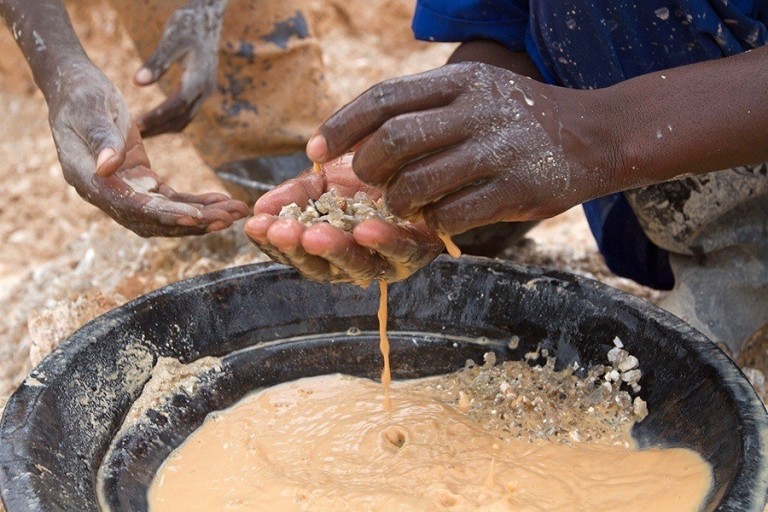Blog
The dark secret powering your cell phone

This post originally appeared on the World Economic Forum's website.
As I stood in New York’s Penn Station on Sunday, commuters in suits and tourists wearing I Love New York T-shirts waited for their trains to Boston, Washington DC and beyond. But looking out over this sea of people, I realised I could only see the tops of their heads. Everyone was looking down, scrolling through the news, typing emails or updating social media on their phones and tablets.
A world away in the Democratic Republic of Congo (DRC), the sun was beating down on a sparse landscape. The sounds of hammers and picks provided a backdrop of noise as people came and went, hauling heavy sacks of rocks to be crushed, washed and sold. Their heads were down, too. Their focus was on gathering as much material as possible to sell at the end of the day.
Every day in the DRC, tens of thousands of men and women take up tools and dig for minerals to earn a living, despite the job’s difficult and dangerous conditions. It is among the hardest labour performed by humans, but it offers the prospect of real economic benefits for those who choose it. The minerals they extract, such as cobalt, are helping to meet the soaring global demand for new technology. Mine workers helped to power every one of those devices in Penn Station.
Mobile power, human toll
From phones and tablets to computers and electric cars, technological innovations that are now commonplace in many people’s lives depend on cobalt. These and other products run on lithium-ion batteries, of which cobalt is a core component. As our appetite for the latest gadget and new forms of green technology, such as renewable energy storage — critical enablers of the Fourth Industrial Revolution — continues to grow, so does the demand for cobalt. The demand for rechargeable batteries alone is expected to more than double by 2024, while the DRC is on course to providing two-thirds of the world’s cobalt within the next two years.
While this sounds good for business, often the benefits do not trickle down to the people who labour daily to mine these precious resources. Growth doesn’t come without challenges — and one of those challenges is child labour in mining.
DRC is rich in natural resources, and it is estimated that more than 10 million of its citizens rely on income from artisanal and small-scale mining across the country. But poverty and income insecurity are also common. Nearly 70% of the population lives below the poverty line of $1 a day. This has inescapable consequences for vulnerable populations, particularly children.
While children under 18 cannot legally work in DRC’s mines, the law is not widely observed for various economic and social reasons. As a result, many children start working in mines at a very young age. What begins as a side activity often grows in significance as the years pass. Over time, families with already limited income and economic opportunities come to depend on the supplemental earnings of their children to cover the cost of household expenses, school fees and other items.
For the children in DRC’s mines, mining isn’t a choice. As one of the worst forms of child labour, it robs them of their childhood, risking their physical and mental development and making them more vulnerable to exploitation.
In January 2017, business, government and civil society leaders from around the world met at the annual meeting of the World Economic Forum in Davos, Switzerland, to discuss how to leverage our collective will to realise a responsible, inclusive and sustainable battery supply chain. As I wrote on this website in February, it is easy to pass the buck to the next person in line, but stakeholders across the supply chain have nevertheless stepped up their response to the labour, human rights and environmental impacts of a supply chain that spans sectors, markets and industries. It is a fundamental shift in how we do business.
Today, at the Sustainable Development Impact Summit in New York, we are proud to publicly launch the Global Battery Alliance. Our mission is to catalyse, accelerate and scale-up action and public-private collaboration towards an inclusive, innovative and sustainable battery value chain.
Alliance for sustainability
The Alliance looks at the battery supply chain — worth $65 billion in 2015 — and related industries as a complete system. It includes industry leaders, original equipment manufacturers, international organisations and NGOs from across mining, technology, environment, development and education industries. It facilitates partnerships and catalyses action for a holistic, systemic approach to market challenges. And, most importantly, it complements and works collaboratively with in-country and cross-border activities already in progress or in the planning stages.
From addressing child labour and dangerous working conditions to water and air pollution and battery lifecycle sustainability, the Alliance has the potential to revolutionise the global battery market. More than that, it will impact the lives of millions of artisanal and small-scale miners and their families who help make the world’s innovations possible.
For Alliance members, this is not only the responsible move, but one that will help all of us be more responsive to our customers — whether those customers are cell phone users in Beijing, households on Southern California’s energy grid, or miners in the DRC.
I hope that others will join us in this transformational, global movement toward a responsible, inclusive, innovative, circular and sustainable global battery value chain.